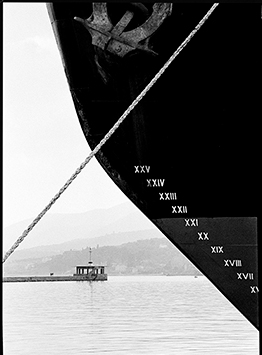PERIORASIS
Depuis les origines la photographie a à voir avec “le Musée imaginaire” – cher à André Malraux. Il s’est agi dans les deux dimensions de l’image photographique de transcrire et de communiquer des volumes sculpturaux qui nourrissent l’origine de notre culture. Le complément de cet emploi de la photographie comme lucarne sur notre civilisation fut l’intérêt pour la Méditerranée, le monde grec et moyen-oriental. Les albums publiés de 1851 à 1855 par Blanquart-Evrard, le premier éditeur au monde de livres photographiques, témoignent avec force de ces deux composantes.
C’est donc à une vieille histoire des relations de la photographie et du visible que nous convie Dimitris Yeros. Vivant à Lesbos, son regard n’a rien à voir avec celui d’un touriste. Il est sans emphase, et ne porte aucun intérêt à l’exotisme et aux curiosités que les guides recommandent de ne pas manquer. Qu’il s’agisse de son île ou de l’Egypte, il reste celui d’un méditerranéen. Sans une once d’orientalisme. Cette vision qui a nourri les rêveries, les fantasmes des aspirants occidentaux au voyage réel ou imaginaire vers la Méditerranée orientale.
Periorasis est une aventure poétique qui met en correspondance, en résonance différentes empreintes du visible. Qu’il se situe en Grèce, en Egypte, en Amérique, l’auteur tisse des ponts entre les formes architecturales, les paysages et les hommes. Son approche, “de style documentaire”, montre à l’évidence que la photographie est une construction interprétative. Lorsqu’elle est maîtrisée, elle présente plus que du visible, elle suscite l’effet qu’il produit. L’artiste photographe n’est pas un miroir passif, c’est un voyant, un interprète doté d’une cosmogonie.
Dimitris Yeros est proche des hommes. Sa conception est très ouverte. La vision. Dans un monde, où les intégrismes, les nationalismes, les intolérances ravagent des pays et même les démocraties les plus anciennes, il est bon de rappeler que la vie est faite d’échanges et que la richesse des civilisations de la Méditerranée est précisément le fruit de ces échanges.
La qualité de la lumière est une autre caractéristique de Periorasis. Que ce soit en Grèce ou en Egypte, elle cisèle la pierre, les bas reliefs. Dimitris Yeros s’empare avec jubilation de cet élément pour en faire la matière première de son écriture. Profondeur de champs maximum, précision du trait, qualité de la couleur du tirage noir et blanc participent à son style. Cela n’a rien de formaliste. C’est seulement la mise en oeuvre d’une distance au visible, d’une philosophie, classique dans le meilleur sens du terme.
La mer baigne ces images. Peut-être Odyssée et circumnavigation sur ce qui représentait le centre du monde pour l’antiquité? Il s’agit plus certainement d’un espace de départ, d’arrachement, d’épreuves des marins loin de leurs îles, d’attente pour ceux qui restent. Nous ne sommes pas loin du “Quart”, de l’écrivain Nikos Kavadias. Periorasis nous parle d’exil. L’autre rive pour l’Europe est maintenant l’Amérique.
Pierre Devin
Février 1999
Δημήτρης Γέρος - ΠΕΡΙΟΡΑΣΙΣ
Από τη γένεσή της η φωτογραφία έχει να κάνει με το «φανταστικό Μουσείο» – το τόσο προσφιλές στον Αντρέ Μαλρό. Κινείται ανάμεσα στις δύο διαστάσεις της φωτογραφικής εικόνας, της καταγραφής και της διάδοσης των γλυπτών όγκων που τροφοδοτούν τις απαρχές του πολιτισμού μας. Συμπλήρωμα αυτής της λειτουργίας της φωτογραφίας, σαν παράθυρο στον πολιτισμό μας, υπήρξε το ενδιαφέρον για τη Μεσόγειο, τον Ελληνικό κόσμο και τη Μέση Ανατολή. Τα λευκώματα που κυκλοφόρησε στην περίοδο 1851-1855 ο Μπλανκάρ-Εβράρ, ο πρώτος στον κόσμο εκδότης φωτογραφικών βιβλίων, μαρτυρούν έντονα αυτές τις δύο συνιστώσες.
Άρα πρόκειται για μια παλιά ιστορία των σχέσεων της φωτογραφίας και του ορατού στην οποία μας προσκαλεί ο Δημήτρης Γέρος. Καθώς ζει στη Λέσβο, η ματιά του δεν έχει καμιά σχέση με τη ματιά του τουρίστα. Είναι χωρίς έμφαση και δεν ενδιαφέρεται καθόλου για τον εξωτισμό και τα αξιοπερίεργα που προτείνουν οι ξεναγοί να μη χάσουμε. Είτε πρόκειται για το νησί του είτε για την Αίγυπτο, παραμένει η ματιά ενός Μεσογειακού. Χωρίς καμιά δόση ανατολισμού. Αυτό το όραμα που έχει τροφοδοτήσει ονειροπολήσεις, φαντασιώσεις μνηστήρων της Δύσης στο πραγματικό ή φανταστικό ταξίδι προς την ανατολική Μεσόγειο.
Η Περιόρασις είναι μια ποιητική περιπέτεια που θέτει σε αντιστοίχηση, σε αντήχηση, διαφορετικές αποτυπώσεις του ορατού. Είτε βρίσκεται στην Ελλάδα είτε στην Αίγυπτο ή την Αμερική, ο δημιουργός χτίζει γέφυρες ανάμεσα σε φόρμες αρχιτεκτονικές, τοπία και ανθρώπους. Η προσέγγισή του, «με ύφος ντοκουμενταρίστικο», αποδεικνύει ότι η φωτογραφία είναι ένα ερμηνευτικό κατασκεύασμα. Από τη στιγμή που τίθεται υπό έλεγχο, παρουσιάζει κάτι περισσότερο από το ορατό, υποστηρίζει το αποτέλεσμα που παράγει. Ο καλλιτέχνης φωτογράφος δεν είναι παθητικός καθρέφτης – είναι ένας οραματιστής, ένας προικισμένος διερμηνευτής μιας κοσμογονίας.
Ο Δημήτρης Γέρος βρίσκεται κοντά στους ανθρώπους. Η «σύλληψή» του είναι πολύ ανοιχτή. Η όραση. Μέσα σ’ έναν κόσμο όπου οι φονταμενταλισμοί, οι εθνικισμοί, οι μισαλλοδοξίες ταλανίζουν χώρες, ακόμα και τις πιο παλιές δημοκρατίες, είναι καλό να υπενθυμίζεις ότι η ζωή φτιάχνεται από ανταλλαγές και ο πλούτος των πολιτισμών της Μεσογείου είναι ακριβώς καρπός αυτών των ανταλλαγών.
Η ποιότητα του φωτός είναι άλλο ένα γνώρισμα της Περιοράσεως. Είτε στην Ελλάδα είτε στην Αίγυπτο, λαξεύει πέτρες και ανάγλυφα. Ο Δημήτρης Γέρος αξιοποιεί με ενοθουσιασμό αυτό το στοιχείο σαν πρώτη ύλη της γραφής του. Μέγιστο βάθος πεδίου, ακρίβεια γραμμής, και ποιότητα ασπρόμαυρης εκτύπωσης συμμετέχουν στο ύφος του. Δεν έχει τίποτα το φορμαλιστικό. Πρόκειται για την εφαρμογή μιας απόστασης από το ορατό, μιας φιλοσοφίας κλασικής με την καλύτερη έννοια του όρου.
Η θάλασσα λούζει αυτές τις εικόνες. Ίσως η Οδύσσεια και ο περίπλους σ’ αυτό που αντιπροσώπευε το κέντρο του κόσμου για την αρχαιότητα; Πρόκειται βεβαιότατα για ένα χώρο αναχώρησης, χωρισμού, δοκιμασιών για ναυτικούς μακριά από τα νησιά τους, αναμονής γι’ αυτούς που μένουν πίσω. Δεν βρισκόμαστε μακριά από τη «Βάρδια» του Νίκου Καββαδία. Η Περιόρασις μάς μιλάει για την ξενιτιά. Η απέναντι όχθη για την Ευρώπη είναι τώρα η Αμερική.
Since its origins photography has to do with the 'Imaginary Museum' – so dear to André Malraux. It moves between the two dimensions of the photographic image, the recording and the communication of sculptured volumes that nourish the origin of our civilisation. A complement of this use of photography, like a window on our civilisation, was the interest in the Mediterranean, the Greek world and the Middle East. The albums published between 1851 and 1855 by Blanquart-Evrard, the first ever publisher of photographic books, are convincing witnesses of these two components.
It is therefore to an old history of relations between photography and the visible that Dimitris Yeros invites us. As he spends part of his life on Lesbos, his look at things is totally different from that of a tourist. It is without emphasis and takes no interest in the exotic or in the curiosities that guides recommend we should not miss. Whether on his island or in Egypt, his look is that of a Mediterranean. Without an ounce of orientalism – the vision which has nourished the reveries and fantasies of Western aspirants on the real or imaginary journey to the eastern Mediterranean.
Periorasis is a poetic adventure that brings together different imprints of the visible. Whether he is in Greece, Egypt or America, the photographer builds bridges between architectural forms, landscapes and people. His approach, of a documentary style, attests that photography is an interpretative construction. Once mastered, it presents more than what is visible and supports the effect it produces. The artist-photographer is not a passive mirror; he is a visionary, an interpreter endowed with a cosmogony.
Dimitris Yeros is close to people. His conception is open. The vision. In a world where fundamentalism, nationalism and intolerance are tearing countries apart –even the oldest among democracies– it is good to remind that life is made up of exchanges and that the richness of the Mediterranean civilisations is precisely the product of such exchanges.
The quality of the light is another characteristic of Periorasis. In Greece or in Egypt, it chisels the stone, the bas-reliefs. Dimitris Yeros makes the best of this element as the raw material of his technique. Maximum depth of view, precision of lines, quality of blacks and whites, all participate in his style. It has nothing formalistic. It is but the application of distance from the visible, of a philosophy that is classic in the best sense of the term.
The sea bathes these images. Perhaps an Odyssey and a circumnavigation of what was the ancients’ centre of the world? It is most certainly an area of departure, of separation, of the ordeals of sailors far from their islands, of waiting by those who stay behind. We are not far from Nikos Kavadias’ ‘The Watch’. Periorasis talks of exile. For Europe the opposite bank is now America.










